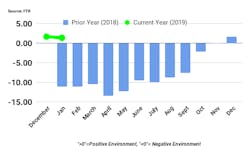FTR’s Shippers Conditions Index for January remains in positive territory
While the January SCI reading at 1.4 is slightly weaker than December’s 1.8 level, it continued in positive territory after consistent negative readings over the past two years. FTR forecasts the SCI to remain close to neutral through Q1 and then to rise slowly as the year progresses. However, even as the SCI is expected to peak in early 2019 Q4, shippers’ conditions will be only marginally positive as capacity remains tight by historical standards.
“While conditions for shippers are forecast to remain neutral to positive over the coming months, it is possible that the duration and extent of flooding in the U.S. Midwest could be a headwind to those improvements, depending on where your freight is moving,” said Todd Tranausky, vice president of rail and intermodal at FTR.
The March issue of FTR’s Shippers Update, published March 8, 2019, details the factors affecting the January Shippers Conditions Index. Also included is an analysis of the driver shortage outlook for fleets.
The Shippers Conditions Index tracks the changes representing four major conditions in the U.S. full-load freight market.
These conditions are: freight demand, freight rates, fleet capacity, and fuel price.
The individual metrics are combined into a single index that tracks the market conditions that influence the shippers’ freight transport environment. A positive score represents good, optimistic conditions. A negative score represents bad, pessimistic conditions.
The index tells you the industry’s health at a glance. In life, running a fever is an indication of a health problem. It may not tell you exactly what’s wrong, but it alerts you to look deeper.
Similarly, a reading well below zero on the FTR Trucking Conditions Index warns you of a problem, and readings high above zero spell opportunity. Readings near zero are consistent with a neutral operating environment. Double digit readings, both up or down, are warning signs for significant operating changes.
“Overall stable fuel prices and more available capacity than was experienced in 2018 will create a relatively calm environment,” added Tranausky.
About the Author
Fleet Owner Staff
Our Editorial Team
Kevin Jones, Editorial Director, Commercial Vehicle Group
Cristina Commendatore, Executive Editor
Scott Achelpohl, Managing Editor
Josh Fisher, Senior Editor
Catharine Conway, Digital Editor
Eric Van Egeren, Art Director
